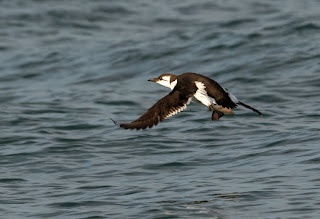The days are getting longer as we move onward through February, so we cast off a little earlier than last week. I grabbed the obligatory morning iPhone pic as we approached the Basnight Bridge making about 16 knots.
photo by Brian Patteson
It's a pretty short run to the ocean from the Oregon Inlet Fishing Center, and by 0644 we were already across the bar. Birdlife was sparse just outside the inlet, but it picked up a couple of miles to the south, and I set a course toward Wimble Shoals, running about four miles off. There was a slightly confused sea with some swell coming in from the northeast and a little chop against it from the southwest. It was not the best conditions for spotting alcids, but we saw well over a hundred Razorbills in the first hour. Some of them were flying well, while others were heavily laden with food.
Razorbill by Brian Patteson
There were also good numbers of Red-throated Loons on the move, mostly northbound, and the most gannets we had seen so far this winter from the boat. Chumming got us some great looks at the gannets, and we soon had a good following of gulls that would stick with us for much of the day. The vast majority were Herring Gulls, but there were also a few Great and Lesser Black-backed Gulls in the mix. All that activity sometimes attracts some other target species, and sure enough, a Manx Shearwater sailed in to check us out.
Manx Shearwater by Brian Patteson
Northern Gannet by Brian Patteson
We had some folks who were keen to see a Common Murre after last week's big day with them, but the murres were not as quick to show themselves. We finally got a good look at one a little while after 8.
Common Murre by Brian Patteson
We found plenty of Razorbills down near Wimble Shoals, but the murres were not as thick as they had been last Thursday. No whales to be found either, so I headed offshore hoping to find some warmer water and different species. We got out to 22 fathoms and it was evident that the color change had pushed off from the day before. Cloud cover overnight meant we didn't have a fresh satellite pic and there weren't many tuna boats out because the Bluefin fishery had closed the day before, so we were flying blind. We did find a few gillnetters fishing in the cooler water, but all we saw among them were more gulls and gannets.
Herring Gull by Brian Patteson
Lesser Black-backed Gull by Brian Patteson
Lesser Black-backed Gull by Brian Patteson
We were about 30 miles from the inlet and the wind was picking up from the south. Water was only about 51 degrees, but no puffins around and we had subpar conditions for spotting one. I set a course for the inlet, and we had a nice ride going down sea. When we got within about 10 miles of the beach we were seeing more alcids and soon found ourselves swimming in Common Murres. It was choppy, but with a following sea they showed pretty well. There were several small flocks, including one bunch of eight! Several of these murres were already in breeding plumage, but the Razorbills were all still in basic. It was a great opportunity to compare the two species, and our guest leader Andrew Thornton got lots of pics. The murres are readily identified by their longer thinner necks and fine pointed bills. On takeoff they invariably throw their feet out to the side and it's really obvious because their tail is so short. Although they are not as portly as a Thick-billed Murre, they definitely have more of a belly than a Razorbill, which looks slim in flight. Given the paucity of Common Murres we encountered during the morning, I would not have expected a new record day for them, but we tallied 39 in a little over an hour and that put us over the top. My West Coast friends wouldn't be too excited, but any day with a new state record count is not too shabby.
Common Murres by Andrew Thornton
Common Murre by Andrew Thornton
Common Murre by Andrew Thornton
Common Murres by Andrew Thornton
Razorbill and Common Murre by Andrew Thornton
Razorbill by Andrew Thornton
Common Murre by Andrew Thornton
Common Murre by Andrew Thornton
While diversity was a bit lower than it sometimes is here, we had a pleasant day at sea with plenty of birdlife. I would like to thank everyone who came out mid week so we could run the trip. It's a short run to the action here, so we don't need to pack the boat to get a trip out. Also big thanks to our mate, Captain Brian King, who dispensed the chum all day like a well oiled machine, and our guest leader Andrew Thornton, who didn't miss much and helped me tally over 3000 birds for the day. I said that's a Dare County problem: having so many birds to keep track of in February.
Species List:
Common Murre: 47
Razorbill: 1050
Bonaparte's Gull:180
Ring-billed Gull: 4
Herring Gull:140
Lesser Black-backed Gull: 11
Great Black-backed Gull: 8(!) very low
Forster's Tern: 3
Red-throated Loon: 580
Common Loon: 46
Manx Shearwater: 5
Northern Gannet: 1400
Bottlenose Dolphin: 40
Loggerhead Turtle: 1
















No comments:
Post a Comment